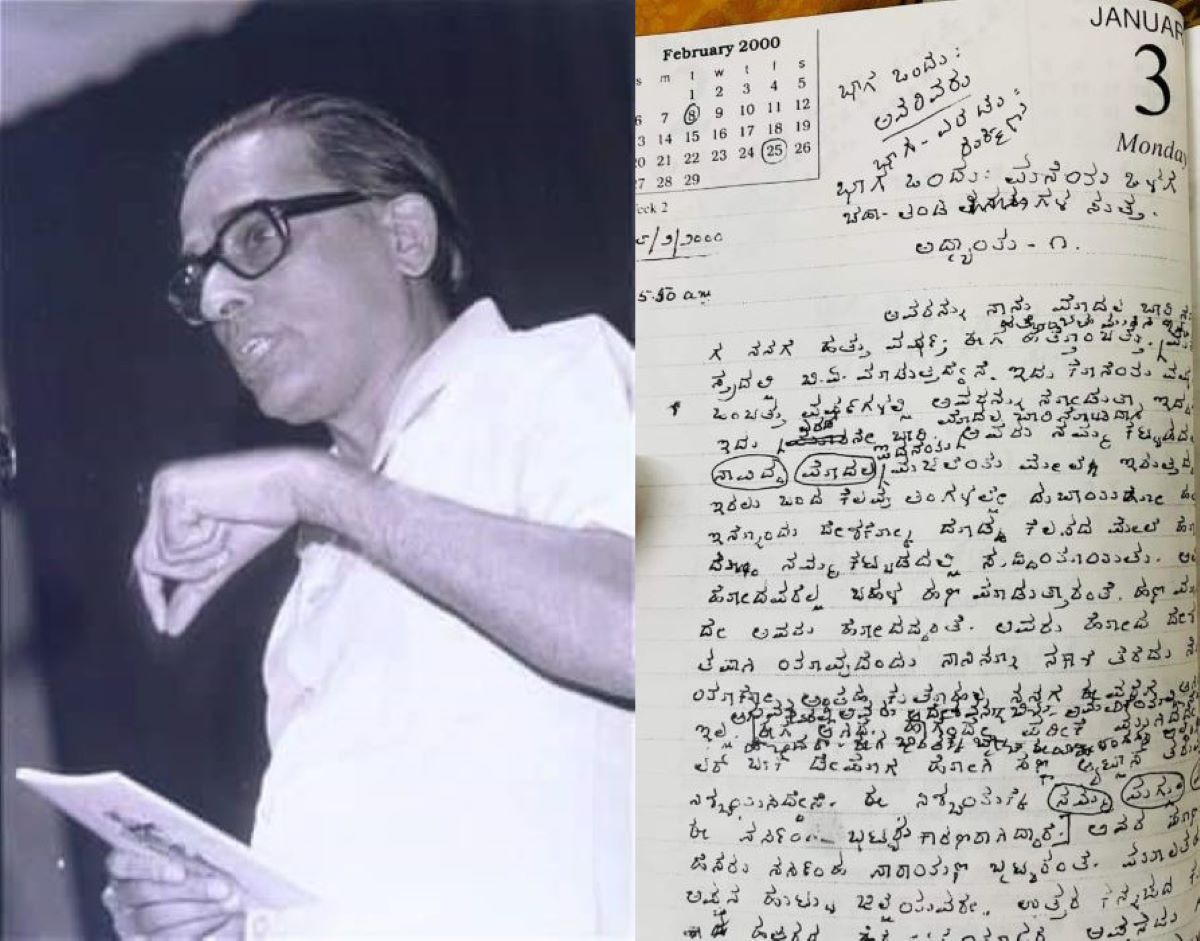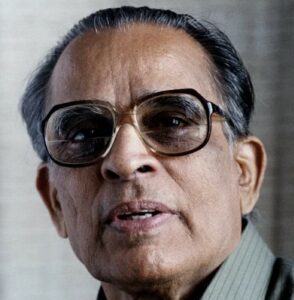(Muralidhara Khajane is a senior journalist, writer, and film critic. He is the author of ‘Random Reflections: A Kaleidoscopic Musings on Kannada Cinema’. These are the personal views of the author)
Yashwant Vithoba Chittal, among the most important Kannada writers of the 20th century, was born in 1928 in Hanehalli, a small coastal village in Uttara Kannada. Hanehalli formed the background for Chittal’s stories, in much the same way that Malgudi did for RK Narayan’s stories.

(L) Kannada writer Yashwant Chittal; (R) a page of 'Digambara' in Chittal's handwriting (Supplied)
What is interesting about many Kannada novelists identified with the Navya movement in Kannada literature is that they arrived at the novel through their short stories. Yashwant Vithoba Chittal, a natural and meticulous storyteller who is among the most important Kannada writers of the 20th century, had published two collections of short stories before he came out with his first novel Mooru Daarigalu.
Like many of his short stories, Mooru Daarigalu also drew upon Chittal’s boyhood and youth in the Uttara Kannada region of Karnataka.
Chittal died before completing his sixth novel Digambara. Eight years after his death, Bahuvachana, a publication house dedicated to bringing out translations, has decided to publish Digambara.
Yashwant Vithoba Chittal, a recipient of the Sahitya Akademi award who died on 22 March 2014, was born in 1928 in Hanehalli, a small coastal village in Uttara Kannada. Hanehalli would go on to leave an indelible impression on Chittal’s writings.
It also formed the background for Chittal’s stories, in much the same way that Malgudi did for RK Narayan’s stories.
Despite spending most of his adult life away from Karnataka, Chittal would immortalise Hanehalli in his works.
Yashwant Chittal, whose first short stories appeared in the early 1950s, spent most of his life in Bombay (present-day Mumbai) working in Bakelite Hylam Limited, from where he retired as the executive director in 1985.
He brought out nine collections of short stories, many of which saw several editions.
His five novels were trend-setting, especially Purushottama and Shikari, and he also published three collections of essays.
A native speaker of Konkani, Chittal became known for using a Konkani-mixed Kannada, a mixture dubbed Konkannada by some fellow writers and critics.
Chittal was the recipient of various awards and honours including the Karnataka Sahitya Academy, the Kendra Sahitya Akademi, and awards instituted in the names of Masti, Shivarama Karanth, and Niranjana.
He was also the recipient of the Pampa Prashasti in 2007. (An award instituted in memory of Pampa, the adikavi of Kannada literature, the Pampa Prashasti is the highest literary honour of Karnataka.)
Yashwant Chittal started writing Digambara in 2000 and stopped after finishing the first part (from chapters 1 to 30 — Naalku Godegala Olage; Chaha Tindigala Sutta), due to illness.
He began to write the second part (from chapters 31 to 39 — Maanava Hetugala Naduve) 12 years later but died before he could complete the novel.
The novel’s unfinished nature gives it a special kind of open-endedness, besides affording room for interpretation.
The last paragraph hints at a kind of continuity, with the narrator and other characters deciding to meet Rukmini (one of the novel’s important characters who hands over a diary to make her point of view) to resolve unanswered questions in the story.
A singular feature of this newly published volume is that it allows readers a glimpse of the manuscript in Chittal’s own handwriting, complete with marginalia.
This unconcluded novel of Chittal also gives readers the chance to (re)explore their understanding of the structure of a novel, reality, human relations, and subjective ‘truth’ among other things while also opening up an infinity of possibilities for them to take the story to a logical end of their own imagining.
In his foreword, the noted literary critic Rajendra Chenni invites the readers into ‘Chittal’s world’.
Introducing both Digambara and Chittal to them, Chenni piques their curiosity about this ‘open to conclusion’ novel. Discussing the matter of a story’s “ending”, Chenni asks an interesting question: Does a story end on its own or does a writer end a story?
He goes on to say there is no definite answer to the question and offers the example of a grandmother or mother telling a child a story until the child falls asleep.
In this case, says Chenni, the story “ends” when the child falls asleep. He goes on to say that these women understand that the world of stories is a world of great anarchy and that, in his opinion, “stories are always acts of sedition though you cannot prosecute them”.
According to Chenni, the uniqueness of Digambara lies in its quality of creating curiosity and the distinct genius of Yashwant Vithoba Chittal in structuring the story through the internal conflicts of his characters.
According to Chenni, a significant feature of Chittal’s writing is his ideological perspective and its metaphysical dimensions.
The characteristic quality of what can be called ‘Chittalness’ (Chittaltana) is finding unimagined complexities in the everyday details of life.
Citing the French literary theorist, essayist, and critic Roland Barthes and his distinction between “readerly” and “writerly” texts, Chenni calls Chittal a “writerly” author.
To clarify, a readerly text is a text that is straightforward and demands no special effort on the part of the reader to understand it; a “writerly” text is one whose meaning is not immediately evident and demands some effort on the reader’s part.
In some ways, Digambara questions the traditional belief of “ending” of a story and argues that it is not necessary to end a story via the traditional narrative structure.
Digambara is not a narration of anyone’s story. It is a search for a story. Not only is the novelist a participant in this search but so is the reader. Their reading the story makes them participants in the collective and holistic search for the story.
Equally, as writer Vivek Shanbhag notes in his introduction, despite Yashwant Chittal not completing the novel in the manner he desired, Digambara is rich enough to offer both a ‘complete’ experience in itself and possibilities for the reader to ‘complete’ the novel in their own minds.
Shanbhag also observes that Chittal might have thought he would live to complete the novel and refers to uncompleted works of Franz Kafka’s, like The Trial and The Castle, as examples of ‘incomplete’ books that have not fazed readers because of their incompleteness.

Yashwant Vithoba Chittal (AN Mukunda)
In his Essays on Modern Kannada Literature, noted literary critic GS Amur makes an interesting observation about Yashwant Vithoba Chittal.
He says that Chittal, as an artist, reveals the wonderful ability to identify with all his central characters — in spite of a wide divergence in their personalities and attitudes.
Additionally, and perhaps of greater importance, is the detachment with which he delineates their lives.
Chittal’s basic concerns, notes Amur, are the essential facts of the human condition — love and death, guilt, fear, pain, and suffering.
These concerns appear over and over again in his works. An intellectual writer who was fascinated by ideas, Chittal had closely studied the ideas of modern thinkers like Freud, Jung, Marx, and Heidegger.
However, despite this interest in modernity and its themes, Chittal had a fundamental mistrust of “isms” and chose not to associate himself with any.
Similarly, though the writer from Hanehalli chose not to align himself with any of Kannada literature’s “movements” — Navodaya, Navya, Bandaya, etc. — several of Chittal’s ideas were a result of his interaction with these movements.
In the long introduction Chittal wrote to the volume of his collected short stories, he said, “I see definite signs of my mind turning towards contemporary happenings and seeking an understanding of contemporary social reality. Many factors have influenced my writing – the confidence I have gained through mastery over the medium, a deep experience and knowledge of modern industrial society, unforgettable events in my own working life, and the movements of Kannada literature”.
Amur notes that these signs are most clearly visible in Shikari, Chittal’s acclaimed novel on the theme of the modern man’s struggle to salvage his human wholeness within a hostile and alienating society.
According to the writer and historian Jyotsna Kamat, Yashwant Chittal’s novels depict characters who struggle with several members of society or with themselves.
Such depictions are Chittal’s forte and can be found in all his works. His experimentation with language, style, and narrative is singular and Digambara is no exception.
(Muralidhara Khajane is a senior journalist, writer, and film critic. He is the author of ‘Random Reflections: A Kaleidoscopic Musings on Kannada Cinema’. These are the personal views of the author)

Apr 16, 2024

Apr 16, 2024

Apr 16, 2024

Apr 14, 2024

Apr 13, 2024